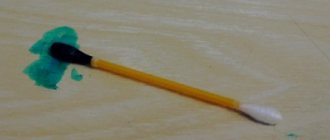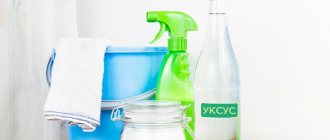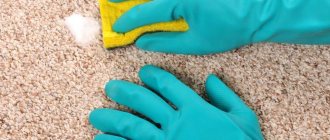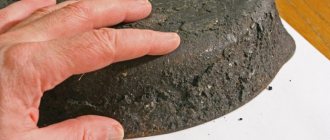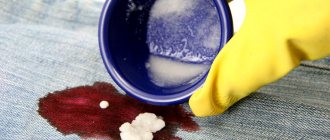General recommendations
Follow these tips:
- Wipe off greasy drops immediately so they don’t have time to dry.
- Test the detergent on a small area first. Treat the surface with the composition, wipe and check the color of the coating after a couple of minutes.
- Do not use harsh abrasives such as powder, otherwise you will damage the top layer of wood or painted surfaces.
- Use soapy water, baking soda, and salt to clean the fittings. Do not use vinegar, alkalis, citric acid or hydrogen peroxide to avoid damaging the metal.
- At the end of cleaning, wipe the kitchen with a damp and dry microfiber cloth - this will remove any remaining cleaning product and stains.
How to clean grease in the kitchen
Any woman who has started general cleaning is faced with the procedure for cleaning fats in the kitchen. You can remove grease deposits and drops from the surface very quickly. In a housewife's arsenal of household chemicals, there will definitely be a means to remove grease in the kitchen, if you have the information.
How to remove greasy deposits in the kitchen? To remove from kitchen surfaces you can use:
- household chemicals;
- soda, ammonia, citric, oxalic acid, vinegar;
- various brushes, kitchen scrapers, soft and rough sponges.
Important! You should clean and remove grease in the kitchen, armed with the necessary and convenient equipment and tools that can make this difficult task easier.
Features of processing different facades
For the manufacture of kitchen furniture, MDF, chipboard, wood, plastic and glass are used. When cleaning, it is important to take into account the characteristics of each material and know how to wash the kitchen set so as not to spoil the color or texture of the surface.
MDF and chipboard
Do not use abrasives or harsh scourers to remove grease from glossy MDF. They leave scratches and spoil the appearance of the headset. Clean the gloss with gentle detergents and soft cloths. To add shine, rub the coating well with paper towels after cleaning.
Clean chipboard with a melamine sponge, alcohol, soapy water and vinegar. The laminated surface can be cleaned with dishwashing gel.
Tree
This is the most difficult material to clean, as it requires delicate care. To remove grease and other contaminants, use professional wood chemicals and soft, lint-free wipes. Do not use peroxide, ammonia, citric acid or other products containing alkali.
After cleaning, do not forget to wipe all surfaces dry. Treat them with polish or wax to protect them from dust.
Plastic
An easy-to-maintain material that withstands moisture well. But some products cannot be used for cleaning. For example, you should not clean plastic facades with aggressive solvents, acetone or chlorine - these compounds discolor the surfaces and lead to tarnishing. It is worth avoiding abrasives: the material is very soft, so it is easy to scratch.
To clean plastic from grease, use dishwashing and glass cleaners. To remove old stains, you will need stronger cleaning products: special pastes, gels and sprays.
Glass
To clean glass facades, avoid products based on alkali, soda and salt. Do not use powders or hard brushes to avoid leaving scratches. Use alcohol-containing compounds: they remove grease perfectly and do not form streaks.
Warning
When starting to clean furniture, carefully read the instructions to make sure for which surfaces the product is intended.
Always test the effect of the drug on a small area that is hidden from view, so that if it fails, the appearance will not be damaged. Only after such a test can you begin to clean the item.
For polished furniture, do not wipe with a damp cloth, as this will dull the shine of the surface.
Do not use abrasive brushes or sponges that will damage the wood surface. The desire to clean dirt from furniture can quickly result in material damage. Try to avoid excessive moisture in wood flooring.
Folk remedies
Some available products effectively deal with fat, but their effect should be checked before processing. They are more budget-friendly than professional cleaners, but only deal with minor stains.
Soda
Quickly and safely removes grease from furniture and is suitable for almost any material.
Mode of application:
- mix baking soda and water in a 2:1 ratio to a creamy consistency;
- apply the mixture to the stained area;
- lightly rub into the surface;
- wash off the residue with a damp sponge after 15 minutes.
The effect of soda will be enhanced by salt. Take both ingredients in equal quantity and add a little water. Apply generously to dirty areas and rinse after 25 minutes.
Salt
This recipe will help remove grease from plastic surfaces. Dissolve 20 g of table salt in a liter of heated water. Soak a cotton rag in the saline solution and wipe down the dirty furniture. if the dirt does not come off, repeat the procedure 2-3 times.
Ammonia
You can remove greasy deposits from kitchen cabinets using ammonia. Dissolve 20 ml of ammonia in a liter of water. Treat contaminated areas: use a spray bottle to do this. After 20 minutes, wipe with a damp sponge. When working with ammonia, do not forget to wear gloves and be sure to ventilate the room after cleaning.
Vinegar
Spray the surface with vinegar using a spray bottle. Sprinkle baking soda on top of the stains. When the active reaction is over, wipe the surface with a damp cloth.
Do not use vinegar on painted surfaces. It can corrode the paint or make the color fade.
Mustard powder
This product is suitable for cleaning facades, electric stoves and refrigerators. Wet the sponge and wipe the problem areas. Then cover the grease stains with mustard powder. After 3-5 minutes, remove any remaining dirt with a clean, dry cloth.
Do not use mustard powder to clean wooden furniture and MDF, as such furniture does not have a protective surface.
Laundry soap
Soap will gently remove grease from any surface. Cleaning algorithm:
- grate half the block on a coarse grater;
- pour in a couple of tablespoons of water;
- apply the mixture to the stains;
- sprinkle soda on top;
- rub the surface with a sponge dipped in warm water;
- leave for 15 minutes;
- Remove any remaining moisture with a clean, dry cloth to prevent dust and new dirt from settling.
Lemon juice and citric acid
Lemon removes fresh grease stains and leaves a pleasant citrus aroma. Cut a couple of lemon slices and rub them on the problem areas. After 25 minutes, soak a clean sponge in warm water and remove any remaining juice and dirt. Wipe the set dry with a paper towel.
If the stains are stubborn, it is better to use citric acid in combination with dishwashing gel. Proceed as follows:
- dilute 15 g of acid in 1 liter of water;
- add five drops of detergent;
- mix and apply to dirty areas with a spray bottle;
- After 40 minutes, when the product breaks down the fat, wipe the surface with a damp sponge.
Citric acid is suitable for cleaning all types of dirt. The product is safe for any furniture except wood, as well as kettles, refrigerators and stoves.
Hydrogen peroxide
Combine peroxide and soda in a 1:2 ratio. Apply the mixture liberally to areas with dirt. After 20 minutes, wipe the surface with a clean cloth. If you don't have soda, you can replace it with table salt.
Do not apply peroxide to dark furniture: the solution has a bleaching effect and will ruin the surface.
Melamine sponge
The product removes old stains of grease and soot. To clean the set, soak the sponge in running water, wring it well and wipe the furniture. The sponge crumbles, so after the procedure you need to wipe the area with a rag.
Do not use melamine sponge to clean interior cabinets, drawers and shelves. Keep it out of the reach of children and animals, as melamine rubber fibers will be harmful if ingested.
Dishwashing liquid
The gel is safe for painted surfaces. Dilute it with water in a ratio of 2:1 and stir to form foam. Treat dirty areas with the mixture. After five minutes, wipe with a dry cloth. If the kitchen set is white, then add 10 drops of hydrogen peroxide to the gel.
What to do if there is a white spot on the furniture?
It may happen that after removing a grease stain, a light stain remains on the furniture. This is especially noticeable on polished furniture. White spots in the form of circles also appear if hot dishes are placed on a polished surface.
If you don't know what caused the stain, try putting a few drops of burdock oil on a cotton pad, wrap the disc in a sock so that the oil seeps out a little, and wipe the white stain with the sock. Remaining oil can be removed with a soft cloth and then rub the surface with flannel. If you can’t find burdock oil, any other oil – flaxseed, olive or sunflower – can successfully replace it.
A white stain from hot dishes can be removed in this way: wrap a small amount of salt in a thin cotton cloth, soak it in vegetable oil and wipe the stain with the cloth. Polish with a cloth piece.
If your head is spinning from the number of different methods, contact our specialists. We are always happy to help you combat any type of pollution.
Order a manager visit for free!
Special means
If folk remedies do not help, buy professional chemistry. Most cleaning formulas are formulated for specific materials, so they remove even stubborn stains gently and safely.
Amway Home Kitchen Cleaner
Liquid product for combating fresh dirt, old grease and soot. Country of origin: Belgium. Suitable for all surfaces except wood, marble and stone. Contains no chlorine, alkalis or caustic acids. Directions for use: mix the concentrate with water in a ratio of 1:3, apply to dirt using a spray bottle. Price for a 500 ml bottle from 500 rub.
Grease remover Bagi Shumanit
Spray to remove congealed fat, carbon deposits and soot. Country of origin: Israel. Suitable for cleaning stoves and grills, hoods, kitchen aprons, pots and pans. Cannot be used on aluminum, Teflon or painted surfaces. Directions for use: apply the product to the contaminated surface, leave for 30–60 seconds. Wipe with a damp cloth and rinse with water. 400 ml of spray is enough for about 100 cleanings. Price from 400 rub.
Cillit Bang Anti-grease
Spray for removing burnt food and oil stains. Country of origin: Russia. Suitable for difficult surfaces, including marble and natural stone, but cannot be used on wooden furniture. Directions for use: spray the spray onto the contaminated surface and leave for 5 minutes. Then wipe with a sponge and rinse with a wet cloth. A 750 ml bottle costs from 200 rubles.
Mr Muscle Kitchen Expert
Spray to get rid of burnt fat, oil splatters and dried sauce stains. Country of origin: the Netherlands. Harmless to any furniture, sinks and stoves. Directions for use: spray the liquid, leave for 30 seconds and remove with a damp cloth. If the surface is wood, painted or aluminum, rinse off immediately. A 500 ml bottle costs from 250 rubles.
How to clean a wooden kitchen
The surface of the upper open and internal closed shelves is often greasy due to a large accumulation of dust, which subsequently turns into a greasy layer. The tabletop and apron are subject to maximum contamination. Therefore, many are interested in how to clean grease from wooden kitchen furniture?
Cleaning such corners requires special effort, since simply wiping and cleaning it with a rag will not work. A wooden surface can be damaged by large amounts of water, mechanical and chemical effects of acids and alkalis. In this case, chemicals are used in the form of a gel component, as well as delicate home cleaning products (sponges, special rags for cleaning).
Vinegar and citric acid or grapefruit will help remove a good layer of old fat. It is necessary to mix the ingredients with water and gently wipe the surfaces with a sponge with light movements without effort. The same composition can be used during the cleaning process:
Note! The main condition is not to use the method of removing dirt using metal brushes to avoid damaging wooden surfaces.
Prevention of kitchen contamination
To prevent grease stains from eating into the surface, follow these rules:
- turn on the hood while cooking;
- wipe the facades with a damp sponge and detergent every day;
- maintain average humidity in the kitchen;
- do not touch handles and cabinets with dirty hands;
- polish wooden facades with a cotton cloth twice a week;
- Order maintenance cleaning from professionals with washing of the refrigerator, stove and microwave, cabinets and countertops.
Is melamine sponge useful for cleaning kitchens?
Melamine sponge - a helper or not? Many housewives liked this new product so much that they began to use it to clean any items. But we must take into account that a soft sponge has abrasive properties that are dangerous for many surfaces.
For example, when washing a stone countertop or ceramic slab, you will erase the protective layer. And without a protective layer, any surface will lose its appearance. Further, it will become vulnerable to various mechanical damages.
But it is extremely effective for cleaning a small spot of grease. You can use this sponge once, but it is not suitable for regular use.
The sponge does not require the use of additional detergents. If you cannot wash off the dried, stubborn grease, use the corner of a sponge to rub the old dirt, then rinse with water.
Rules for using melamine sponge:
- Do not scrub the stain with the entire surface of the sponge.
- Do not use melamine dry, only moistened with water.
- Do not clean the dishes without removing the coating.
- This item should not be twisted or squeezed. Once twisted, it will no longer be suitable for cleaning dirt.
- No other cleaning products should be used with melamine.
- When cleaning surfaces, it is not recommended to press hard.
- The sponge should not be stored near food. Special stands are used for it.
- Can only be used with gloves.
Main
- Before deciding how to remove grease from kitchen furniture, determine the type of surface. For example, painted surfaces and wood should not be treated with abrasives or strong alkali.
- The safest traditional methods: cleaning with laundry soap and dishwashing gel - they do not leave scratches and do not spoil the color.
- Before using special chemicals, read the instructions: some products have recommended dosages.
- Wipe off grease after each cooking. It is easier to clean minor stains immediately than to scrub away old stains with professional chemicals.
How to wash a plastic kitchen
Kitchen surfaces made of plastic also require careful handling during cleaning. The grease remover can also be used without abrasives in kitchens made of plastic and with varnished surfaces.
Laundry soap should be in every home. It is antibacterial and will help clean. Soap combined with baking soda gives an excellent effect.
Special means
Today, manufacturers offer a number of specialized cleaning compositions (for example, Unicum). Among them are:
- from grease in the kitchen;
- for cleaning the bathroom;
- for cleaning furniture;
- for the care of plastic surfaces, etc.;
- for polishing furniture.
Using these products, you can quickly clean double-glazed windows and plastic window sills, laminate flooring and other kitchen surfaces. Names and prices vary widely. The owner will have to choose which drug will be used as a means to remove fat.
Important! For use in non-professional activities, it is worth choosing products that do not pose a danger to the health of the housewife and pets.
Ways to remove oil from wood
You should try to remove a fresh oil stain from the wood using improvised means, sprinkling it with dry sand. If the wood is painted or sanded, you can wash the stain with warm water and a grease-dissolving soap (such as dishwashing detergent).
Many people try to deal with oil on wood mechanically, scraping it off with a sharp object along with the top layer of the wooden product (scraper, spatula, scraper, etc.). They use hand-held power tools - an angle grinder, a drill with a special attachment.
Such attempts help solve the problem of how to remove oil from wood, only in a small area. For production scales, it is better to take advantage of modern technologies offered by the chemical industry.
Should I remove oil from wood?
Untreated wooden surfaces are often coated with oil-based drying oil. This procedure is done to protect the tree from the penetration of excess moisture. In this way, the wood is primed before painting. But how can you remove oil from a tree if it got there unexpectedly?
The porous structure of wood is saturated with oil very quickly. Where the oil stain appears, dust and other debris collects. Wooden floors made of timber, parquet, wood panels on which oil stains have appeared take on an unsightly appearance. Wood saturated with fatty substances is easily flammable, which creates a fire hazard in the room. Oil stains need to be dealt with and it is advisable to do this immediately after they appear on the wood.
Stains after eating and drinking
Drink and food stains can be removed from composite boards by scrubbing the surface with diluted dishwashing liquid and then rinsing with water.
It is also appropriate to use a floor washing machine. The water pressure from the nozzle should not exceed 100 bar. The cleaning nozzle should be installed at a distance of approximately 30 cm from the surface of the board. During washing, it should be moved in the direction of the corrugation of the boards. It's best to avoid performing circular motions and not using multi-thread mode.
Cigarette marks
To remove traces of blackening from the boards, for example, from a cigarette or coal, the surface will have to be sanded. To do this, use fine-grained sandpaper or a steel brush. Before sanding, the surface of the board must be moistened with water. It should be carried out carefully, in accordance with the corrugation instructions, thereby avoiding possible damage to the surface of the material. After sanding the top layer of the board, its surface may have a darker color. This slight difference in color will even out after some time.

